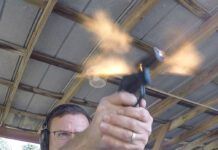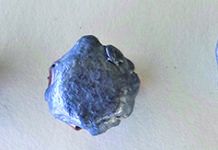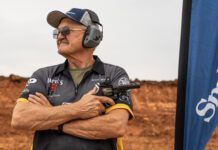We have tested a variety of 22 LR Single Action Army (SAA) revolvers in the past, and those six-shooter revolvers have been the traditional models with 4.75- or 6.5-inch barrels. In this match-up, we wanted to look at shorter-barrel SAA revolvers in 22 LR. So we gathered two Heritage Manufacturing Barkeep models and two Ruger Shopkeeper revolvers. These pistol designs share a similar idea: Abbreviated barrels.
Ever since SAA revolvers were invented, gunsmiths have lopped off a good portion of the barrel to make the pistol easier to carry as a back-up gun. In fact, Colt made centerfire Sheriff models with short barrels and without the ejector rod, and a centerfire 4-inch-barrel Storekeeper’s model with an ejector rod. In the recent past, a variety of SAA manufacturers and importers have introduced short-barrel SAA revolvers.
The assembled SAA rimfire revolvers are at polar opposites are far as price is concerned. The Heritage Mfg. Barkeep models are under $200, and the Ruger Shopkeeper models are about $500 to $575. That’s a difference of $300 to $375 if we do the math correctly. We know what you are thinking: Are the Ruger models worth the extra coin?
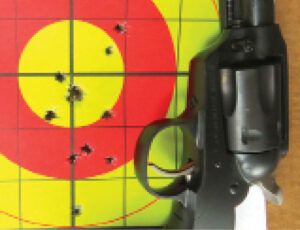
Where the four revolvers are similar is in chambering, size, weight, barrel lengths, and sights. The Heritage Barkeeps and Ruger Shopkeepers are scaled down so they fit adults as well as small-stature shooters. All of these rimfire revolvers had similar barrel lengths between 2.6 and 3.5 inches and traditional SAA sights, consisting of a front blade and a rear groove notch. Grip style is where the Barkeep and Shopkeeper revolvers differ. The Barkeep models have a traditional SAA grip, while the Shopkeeper models have a smaller bird’s head-style grips. We have gripes about the grips, as you’ll read below. All four are smart-looking revolvers with different finishes that vary in execution.
We think three of these compact SAA revolvers would make fun plinkers. The Rugers are small enough to drop in your back pants pocket or coat pocket when taking a stroll or walking the woods. Tin cans and paper targets don’t care what we use to shoot at them, but as shooters, we care, a lot.
How We Tested
Burning through a bunch of 22 LR ammo, we found all four pistols performed well, though we did find the Rugers more user friendly due to their ejector rods. Sticky empties did not fall free from any of the guns, but a rod with a wood handle, which comes with each Barkeep, helped eject stubborn cases. We tested three flavors of ammo: Remington Thunderbolt with a 40-grain lead round-nose bullets, Winchester Xpert High Velocity rounds with 36-grain hollow points and some zing, and a 38-grain LRN from CCI Blazer. These rounds have a range of velocities and bullet weights and styles, from target rounds to hunting rounds. We had issues loading the Winchester ammo in the Rugers, but not in the Heritage guns. Using our range bag as a rest and firing five-shot groups at cardboard targets, we tested for accuracy at 15 yards. Both Rugers and one of the Heritages shot to point of aim, which is a requirement for a fixed-sight revolver. One of the Barkeeps shot to the left, which doomed it in our eyes. Still, we thought there were some “keepers” in this group.
Gun Tests Grade: A-
$729
The Bearcat was introduced in 1958 and quickly soared in popularity. The revolver’s small size is great for campers, hikers, and fisherman who might need to deal with a cottonmouth. And as for plinking? Fuggedaboutit! To say the Bearcat is iconic doesn’t do it justice. The original Bearcat grip frame is actually based on a downsized Remington 1885 revolver. When Ruger introduced the New Model SAA revolvers in the mid-1970s, the Bearcat was not part of the transition. Ruger finally brought back the New Model Bearcat in 1993 with the transfer bar safety system and has since produced a plethora of Bearcat-model variants. All Bearcats, including the Shopkeeper variants, are chambered for the 22 LR but are also compatible with 22 Short, 22 Long, and 22 CB caps.
| Action Type | Revolver, single action |
| Overall Length | 8.0 in. |
| Overall Height | 4.2 in. |
| Barrel Length | 3.0 in., 1:16 |
| Sight Radius | 4.0 in. |
| Maximum Width | 1.2 in. |
| Weight Unloaded | 22.0 oz. |
| Weight Loaded | 22.7 oz. |
| Cylinder Gap | .004 in. |
| Capacity | 6 |
| Frame Material/Finish | Satin stainless steel |
| Cylinder Material/Finish | Satin stainless steel/unfluted |
| Frame Front Strap Height | 1.9 in. |
| Frame Back Strap Height | 2.9 in. |
| Grips | Smooth laminated hardwood |
| Grip Thickness (max) | 1.0 in. |
| Grip Circumference (max) | 4.0 in. |
| Front Sight | Blade |
| Rear Sight | Fixed groove |
| Trigger Pull Weight | 4.1 lbs. |
| Trigger Span | 2.7 in. |
| Safety | None |
| Warranty | None stated |
| Telephone | (336) 949-5200 |
| Website | Ruger.com |
| Made In | USA |
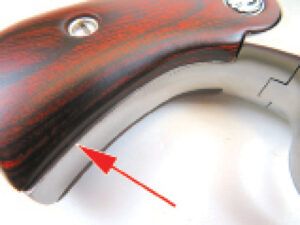
The Ruger Shopkeeper is based on the Ruger New Model Bearcat, but with a few changes. The most obvious are the abbreviated 3-inch barrel and birdhead’s grip. The less obvious change is the Shopkeeper features an all-stainless-steel construction, including the ejector rod housing. Other variants of the Bearcat contain some aluminum components. Since the barrel is shorter on the Shopkeeper, the ejector shroud was shortened from 4 to 3 inches and ejector rod head redesigned to a U-shape to accommodate the shorter barrel and cylinder pin. The U-shaped ejector-rod head is designed to allow removal of the cylinder pin.
In hand, the small grip makes the Shopkeeper feel even smaller than the traditional Bearcat. Also, because it is constructed of stainless steel, the Shopkeeper feels substantial in the hand. In our opinion, this Shopkeeper is a sharp-looking revolver. Balance is excellent, though is does feel small.
Like the other Ruger New Model SAA revolvers, the Bearcat Shopkeeper has a transfer bar safety; that means the revolver can be carried with six loaded.
The satin-stainless finish and metalwork was well executed. The unfluted cylinder has the classic Bearcat engraving of a cougar and a bear. The beautiful laminate grip panels are smooth and feature a tasteful Ruger medallion. We did note that the right grip panel was not fitted perfectly and exposed the edge of the grip frame. Is that petty? Yes, but this revolver is expensive and we expect better.
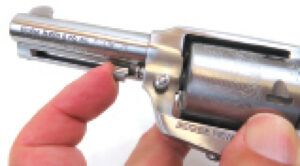
The sights consist of a fixed rear notch and groove that’s milled into the top strap, and the front is a rounded blade. The rear section of the rear groove is milled out to reduce glare when aiming. The hammer spur is wide with fine serrations that provided excellent traction when thumbing back the trigger on the handgun.
There are four distinct clicks when cocking the hammer. The first click is the loading notch. The second click is the cylinder latch popping up against the cylinder. The third is the cylinder latch going into a cylinder notch, and the fourth click is the hammer reaching full cock. The third and fourth clicks are very close together. Pull the hammer back very slowly, and you will hear a distinct third and fourth click.
The trigger is skinny, with no sharp edges. It broke at 4.1 pounds with a barely discernible amount of creep. We liked the trigger.
The loading gate can be opened with the hammer in any position. Pull the hammer back to the first click to allow the cylinder to rotate one way and load the revolver. The chambers in the cylinder are countersunk, so make sure the cartridges are fully seated in the chamber or they will bind. The loading gate is small, so there was not a lot of room for fat fingers and tiny 22 LR cartridges. The loading gate was easy to open and close.

When going hot, we did well with this diminutive revolver. In fact, the 3-inch Shopkeeper had the second-best accuracy of the guns tested. It also had, on average, more velocity and energy at the muzzle than the 2.6-inch-barrel Barkeep. The cylinder gap measured 0.004 inch, which is nicely in spec. It shot to point of aim. The best five-shot group was with inexpensive 40-grain Remington Thunderbolt ammo that measured 0.51 inch. Wow! The CCI Blazer with the 38-grain LRN came in a close second with a group that measured 0.97 inch. The Winchester ammo, however, gave us fits. We found some of the bullets were a bit oversized, either with lead or dry lubricant, making some very difficult to load. We also had a hard time ejecting the Winchester cases with the ejector. Not only did the cases stick, the corners of the ejector head were sharp, making it uncomfortable to use. We eventually disassembled the Bearcat and used the cylinder pin to punch out the Winchester cases. Interestingly, the Remington and CCI cartridges dropped into the chambers of the Rugers. We chalk this up to ammo because we did find some of the Winchester rounds would easily load, while others did not. The Winchester ammo also easily loaded into the Heritage revolvers. One thing to note with the Ruger is the chambers are counterbored, so you need to fully seat the round or you run the risk of the cylinder binding. We only had the issue with the Winchester load; the Remington and CCI worked fine and ejected easily. Our best group with the Winchester ammo measured 1.22 inches.
On average and with all ammo types, the Ruger averaged 1-inch groups. In our opinion, this type of accuracy from a small revolver is excellent. The trigger-pull weight was a hair over 4 pounds, but we found we could still be surgical with our shots.
The U-shaped ejector rod head was tiny, and the corners of the head were sharp. Ruger should round the corners to make the ejector-rod head more user friendly. It also did not rotate away from the barrel, and we could feel the warm barrel with our finger tip when ejecting rounds during extended firing. The Bearcat Shopkeeper field-strips simply, but the head of the cylinder pin was small and hard to grasp with fat fingers. We used a fingernail inserted into the groove in the cylinder pin to pull it free. After that, it was a breeze to disassemble.
Our Team Said: The 3-inch Shopkeeper is an elegant little Ruger rimfire revolver. It shot to point of aim and feels substantial in hand. The ill-fitting grip panel and the sharp-cornered ejector head are mistakes. We would buy this gun, but would take a Dremel tool to buff down the sharp edges.
22 LR Range Data
| Remington Thunderbolt 40-grain Lead Round Nose | Heritage Barkeep 2.6 in. | Heritage Barkeep 3.6 in. | Ruger Shopkeeper 3 in. | Ruger Shopkeeper 3.5 in. |
| Average Velocity | 860 fps | 1001 fps | 848 fps | 981 fps |
| Muzzle Energy | 66 ft.-lbs. | 89 ft.-lbs. | 72 ft.-lbs. | 85 ft.-lbs. |
| Smallest Group | 0.88 in. | 1.24 in. | 0.51 in. | 0.53 in. |
| Average Group | 1.20 in. | 1.29 in. | 0.58 in. | 0.66 in. |
| CCI Blazer 38-grain Lead Round Nose | Heritage Barkeep 2.6 in. | Heritage Barkeep 3.6 in. | Ruger Shopkeeper 3 in. | Ruger Shopkeeper 3.5 in. |
| Average Velocity | 917 fps | 1007 fps | 939 fps | 892 fps |
| Muzzle Energy | 71 ft.-lbs. | 89 ft.-lbs. | 74 ft.-lbs. | 67 ft.-lbs. |
| Smallest Group | 1.14 in. | 1.10 in. | 0.97 in. | 0.73 in. |
| Average Group | 1.89 in. | 1.13 in. | 1.10 in. | 0.93 in. |
| Winchester Xpert HV 36-grain Hollow Point | Heritage Barkeep 2.6 in. | Heritage Barkeep 3.6 in. | Ruger Shopkeeper 3 in. | Ruger Shopkeeper 3.5 in. |
| Average Velocity | 939 fps | 1048 fps | 947 fps | 952 fps |
| Muzzle Energy | 70 ft.-lbs. | 88 ft.-lbs. | 72 ft.-lbs. | 72 ft.-lbs. |
| Smallest Group | 2.88 in. | 1.56 in. | 1.22 in. | 1.22 in. |
| Average Group | 3.31 in. | 1.65 in. | 1.38 in. | 1.23 in. |
Value Guide: Single-Action Revolver Rankings
| Gun Name | Issue | Grade | Comments |
|---|---|---|---|
| Traditions 1873 Frontier SAT73-002 45 Colt, $614 | Apr. 2022 | A | Best Buy. The revolver is a good buy and will serve well in any role a single-action revolver is suited for. |
| Colt Single Action Army Wiley Clapp P1842WC 45 ACP, $1900 | Apr. 2022 | B | It is expensive, but it is also very good. The very tight base pin was an aggravation in disassembly. |
| Colt Single Action Army P1840 45 Colt, $2400 | Apr. 2022 | B- | The Colt is well made and reliable. The rough trigger action soured our shooting experience with it. |
| Ruger Bisley Hunter 0862 44 Magnum, $1149 | Jan. 2022 | A | The recoil impulse on the Bisley was more comfortable than the standard Super Blackhawk. |
| Ruger Super Blackhawk 44 Magnum, ~$660 | Jan. 2022 | A- | The Pachmayr grips helped hold onto the pistol in movement, almost a bit too well. |
| Heritage Rough Rider Combo 22 LR/22 WMR, $250 | 2021-05-01 00:00:00 | A | Best Buy. Came with a spare 22 Magnum cylinder. The fit and finish are good, had a nice set of cocobolo grips. |
| Ruger Wrangler No. 2004 22 LR, $250 | 2021-05-01 00:00:00 | A- | Reliable, the action is smooth and positive in operation. Accuracy is the best of the test. |
| Traditions 1873 Rancher PVC SAT73-22250 22 LR, $229 | 2021-05-01 00:00:00 | A- | Modified to a transfer-bar system. Also features a hammer-spring tensioner. |
| Chiappa 1873-22 No. 340.250 22 LR, $185 | 2021-05-01 00:00:00 | C | Accuracy isn’t terrible, but it is disappointing. The action was its greatest demerit. |
| Ruger Wrangler Model 2003 22 LR, $210 | 2020-06-01 00:00:00 | A | Shot to point of aim, was accurate, fun to shoot, and costs a fraction of what a Single-Six does. |
| Uberti Cattleman 22 Model 356186 22 LR, $453 | 2020-06-01 00:00:00 | A | A traditionally styled revolver that is well made and accurate. Extra capacity is a plus. |
| Cimarron Plinkerton ASPLINK1 22 LR, $172 | 2020-06-01 00:00:00 | B | Rough fit and finish. It did not shoot to point of aim, but it was accurate. |
| Traditions 1873 Liberty Model SAT73-119LIB 357 Mag., $550 | Mar. 2019 | A | Best Buy. A combination of accuracy and good handling make it the best buy of the test. |
| Traditions 1873 Sheriff’s Model SAT73-005 357 Mag., $410 | Mar. 2019 | B | The shorter barrel limited its performance in all regards, including accuracy, energy, and a full powder burn. |
| Traditions Frontier 1873 PVC SAT73-126 357 Mag., $550 | Mar. 2019 | B | The Frontier revolver must have had a burr in the action of some sort that caused a function problem. |
| BFR Short Cylinder BFR44MAG7 44 Magnum, $1184 | Aug. 2018 | A | Well made, heavy revolver that was accurate, has manageable recoil, and can accept a scope. |
| Cimarron Bad Boy CA360-BAD BOY 44 Magnum, $687 | Aug. 2018 | A | Offers a classic single action with a modern twist by using a Colt 1860 Army-style grip and octagonal barrel. |
| EAA Bounty Hunter 770080 44 Magnum, $520 | Aug. 2018 | B+ | Good accuracy and easy recoil management. The trigger was too heavy, and it did not shoot to point of aim |
| Colt Single Action Army 2nd Generation 45 Colt, $1240 | 2018-07-01 00:00:00 | A | Our Pick. The Colt was well finished, felt good in the hand, and was quite accurate. |
| Uberti 1873 Cattleman Old West No. 355131 45 Colt, $400 | 2018-07-01 00:00:00 | B+ | Best Buy. Though it lagged a step in accuracy, the Uberti exhibited the best trigger of the test. |
| Ruger Vaquero Bisley 5129 45 Colt, $550 | 2018-07-01 00:00:00 | B | The grip frame and trigger helped in deliberate fire. The Ruger was the most accurate revolver tested. |
















